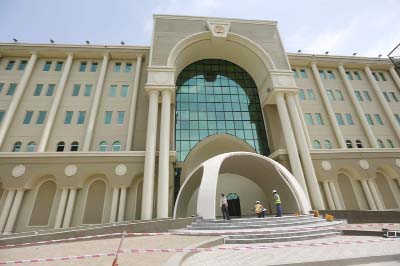
AP, Kabul :
They call it the “mini-Pentagon” — a white marble building in the heart of Afghanistan’s capital built with U.S. funds to serve as the headquarters of a modern military more than a decade in the making.
But the newly constructed building is a world apart from the front-lines of Afghanistan’s unfinished war, where soldiers huddled at exposed checkpoints increasingly rely on police and local militias, and where logistical bottlenecks almost led to the loss of a key northern city to insurgents who swept across the northern plain in April.
U.S. officials told The Associated Press during an exclusive tour of the building that the new $160 million Defense Ministry will help the military streamline its operations and more effectively counter the Taliban now that the U.S. and NATO combat mission has officially ended.
The five-story building with a 34-meter (110-foot) dome will accommodate 2,500 employees, with barracks for officers and enlisted men, an ancillary garrison as well as a wastewater treatment facility and a power plant. Three dining halls can seat a total of 1,000 people, and an auditorium more than 900. The sprawling compound also includes gyms, clinics and military courtrooms.
The design for the 38,500 sq. meter (414,500 sq. foot) structure was chosen from entries in a nationwide competition open to architecture students. The resulting building, a combination of the top two designs, has taken four years to complete. Some 70 tons of furniture, along with fixtures and computer equipment, have added another $33.3 million to the U.S. taxpayer-funded bill, and information technology alone will add another $12 million.
“We now have the ability to be able to see the progress and the potential of everything that the security forces in Afghanistan can do,” said U.S. Maj. Gen. Todd Semonite, the American commander overseeing the transition, calling it “a new beginning for the Ministry of Defense.”
There’s at least one key element missing – a defense minister.
President Ashraf Ghani has yet to fill the post in the nine months since assuming office because of infighting with Chief Executive Abdullah Abdullah, the man he defeated in a hotly disputed election. It’s hoped that his fourth nominee, Masoom Stanekzai, will be confirmed later this month, in time for the ribbon-cutting ceremony.
They call it the “mini-Pentagon” — a white marble building in the heart of Afghanistan’s capital built with U.S. funds to serve as the headquarters of a modern military more than a decade in the making.
But the newly constructed building is a world apart from the front-lines of Afghanistan’s unfinished war, where soldiers huddled at exposed checkpoints increasingly rely on police and local militias, and where logistical bottlenecks almost led to the loss of a key northern city to insurgents who swept across the northern plain in April.
U.S. officials told The Associated Press during an exclusive tour of the building that the new $160 million Defense Ministry will help the military streamline its operations and more effectively counter the Taliban now that the U.S. and NATO combat mission has officially ended.
The five-story building with a 34-meter (110-foot) dome will accommodate 2,500 employees, with barracks for officers and enlisted men, an ancillary garrison as well as a wastewater treatment facility and a power plant. Three dining halls can seat a total of 1,000 people, and an auditorium more than 900. The sprawling compound also includes gyms, clinics and military courtrooms.
The design for the 38,500 sq. meter (414,500 sq. foot) structure was chosen from entries in a nationwide competition open to architecture students. The resulting building, a combination of the top two designs, has taken four years to complete. Some 70 tons of furniture, along with fixtures and computer equipment, have added another $33.3 million to the U.S. taxpayer-funded bill, and information technology alone will add another $12 million.
“We now have the ability to be able to see the progress and the potential of everything that the security forces in Afghanistan can do,” said U.S. Maj. Gen. Todd Semonite, the American commander overseeing the transition, calling it “a new beginning for the Ministry of Defense.”
There’s at least one key element missing – a defense minister.
President Ashraf Ghani has yet to fill the post in the nine months since assuming office because of infighting with Chief Executive Abdullah Abdullah, the man he defeated in a hotly disputed election. It’s hoped that his fourth nominee, Masoom Stanekzai, will be confirmed later this month, in time for the ribbon-cutting ceremony.

